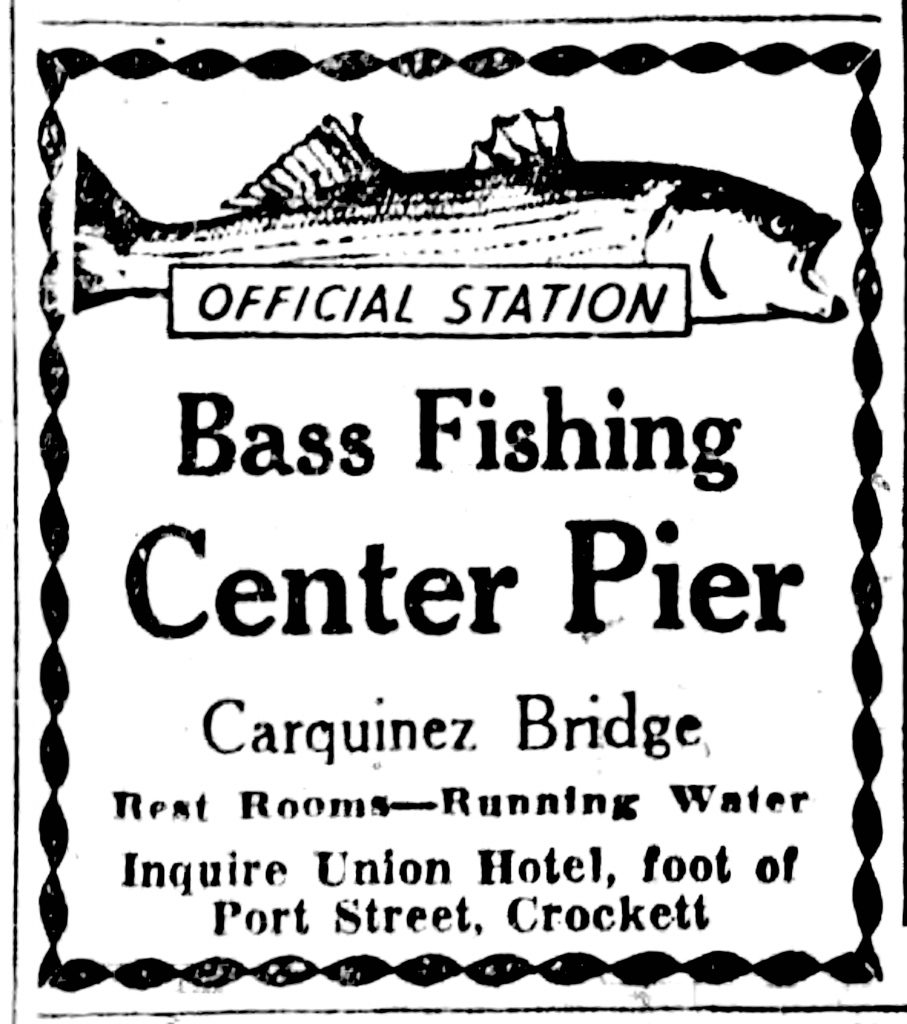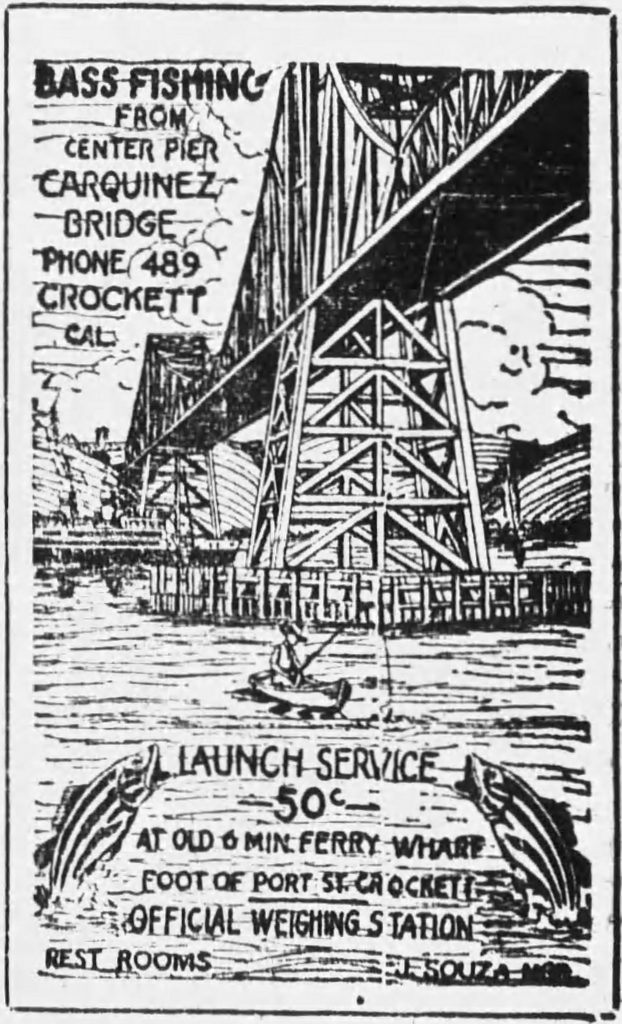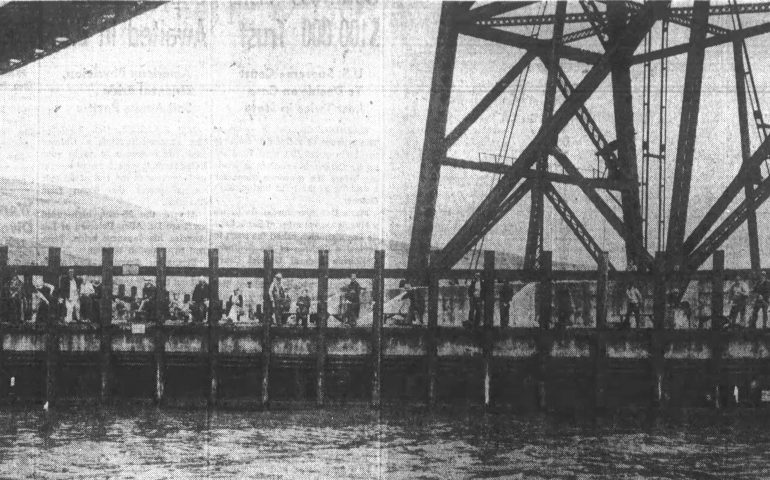When I lived in the East Bay in Pinole in the1970s, one of the piers I frequently fished was the Dowrelio Pier in Crockett, a pier that was often good for striped bass and one that always offered the possibility of a sturgeon. The pier, which is now closed, was located just under and west of the Carquinez Bridge that connects Crockett with Vallejo. It was hard not to hear the din of the traffic from the bridge as you fished and there were times when I looked at the bridge supports and thought how great it would be to fish from them in the deeper water.
At the same time, I never imagined that once there actually was a pier connected to those supports. Then, one day when I was checking old newspapers for information on piers, I ran across information on boats fishing just off the center pier of the original Carquinez Bridge. Apparently it was a good spot to fish for striped bass. Next, I ran across mention of a 300-foot fishing pier under the bridge!
Angler’s Given New Clubhouse
Bass Fishermen of the Athens Athletic Club will enjoy piscatorial pastime in luxury this season as a result of a gift of Oscar Klatt of a new fishing clubhouse and 150 feet of additional pier at the north end of the bridge on Carquinez Strays. Klatt, a club member and president of the American Toll Bridge Company, has set aside the pier and clubhouse for exclusive use of Athens Club members, their families and friends, and announced that it is ready for use.
Beach Dean, chairman of the Athens house committee, has supervised the furnishing of the clubhouse. It will contain a complete assortment of cooking utensils, dishes, a refrigerator, and electric stove. The living room, with a fireplace, is attractively furnished while beach furniture on the pier will enable anglers to cast in comfort.
Klatt also announced that if there are any fish in the Straits that club members will be able to hook them for in addition to the club’s 300-foot pier, a new wharf has been constructed under the bridge, extending into feet ? of water. This wharf, as well as the ferryboat moored in the cove, will be available for members. —Oakland Tribune, May 2, 1933
Private pier under the bridge? I wasn’t sure (and still need additional research on when/where/how) but a Center Pier on the bridge soon showed up in articles. Was it private or public? Hard to say but it appeared to be public.

An improvement is being noted around the Center Pier of the Carquinez Bridge. Pork rind is proving a delectable tid-bit for the bass. A 33-pounder was reported yanked from the pier.—Oakland Tribune, April 13, 1934
In the list of weigh stations for the 1934 Oakland Tribune’s HUGE bass derby was the “Center Pier” at the Carquinez Pier.
Bridge Fishing Fine
The Center Pier of the Carquinez Bridge continues to furnish excellent sport. Joe Lundgren hooked a limit fro 4 to 8 pounds; John Glasky caught a limit from 4 to 12 ½ pounds. Others were Dick Gillio of Oakland, 10 pounds; J. E. Tucker of Vallejo, 14 pounds, which he caught on a 2-0 hook; Edwin J. Lemmle of Oakland, 7 and 10 ¼ pounds; and Joe Clair of Berkeley, 5 and 7 ½ pounds. The majority of fish were taken on the pier during the last two hours of the run in and the first two hours of the run out, or on the flood tide. —Oakland Tribune, June 21, 1934
Crockett Angler gets Big Bass
The thrill which comes only once or twice in a fisherman’s lifetime! Jerome L. Thompson of 1850 Wanda Street, Crockett, today had a 34-pound, 9-ounce striped bass. The catch was made from the pier of the Carquinez Bridge Bass Club after 30 minutes of stubborn fight, during which the striper broke water. Although he had been fishing for 10 years, this week’s catch was by far the largest ever scored by Thompson. His luck has run as high as a 14-pounder. Jim Larison of Crockett, Thompson’s fishing partner, wielded the gaff to insure permanent capture of the bass. —Oakland Tribune, July 3, 1937

Interesting was a write up about the Tribune’s big bass tournament on October 1, 1938, Among the rules was the following pertaining to the Carquinez Bridge: “It was decided to allow fishing from any point on the Carquinez Bridge, the southern boundary of the official area. Boats will not be allowed to cross under the bridge without being eliminated from the derby, but the fishermen standing on the center pier can allow their lines to drift south of that point.”
It appears that the use of the bridge piers may have stopped with the advent of World War II and the concern that anyone near the bridges or piers (on the piers or in a boat) had to have identification cards proving citizenship, employment and good character.
Hopefully additional information can be obtained on this pier.

Yeap, my Grandfather. His brother, my great Uncle Joe, had a small restrurant on the center pier. Coffee, sandwiches, fishing tackle, etc. When WW II
broke out the givernment actually asked my grandfather if he would surrender his lease for the center pier. He readily agreed.